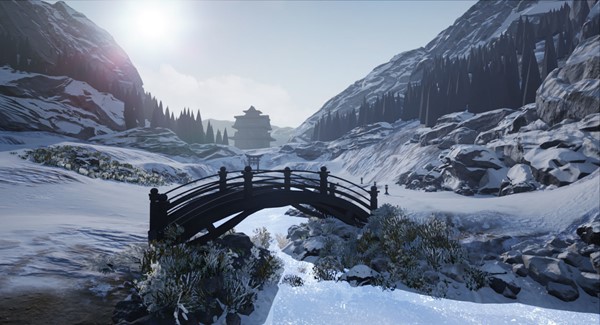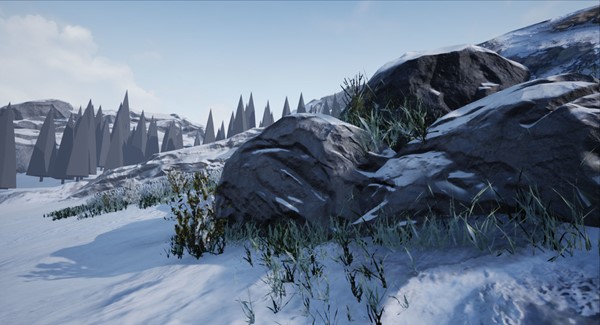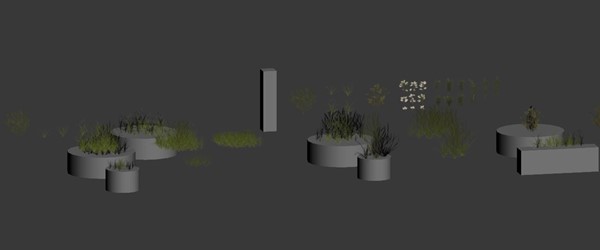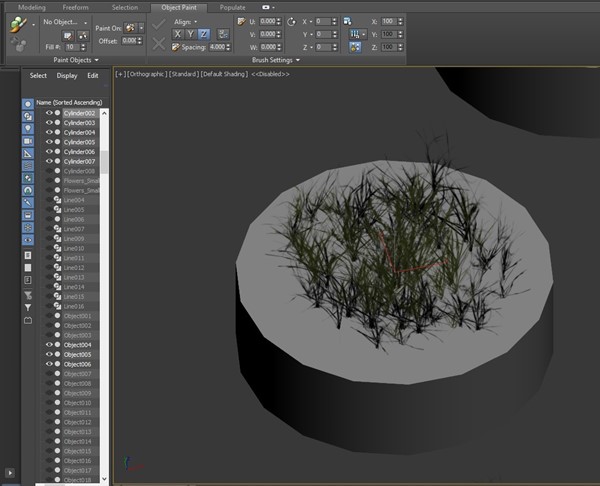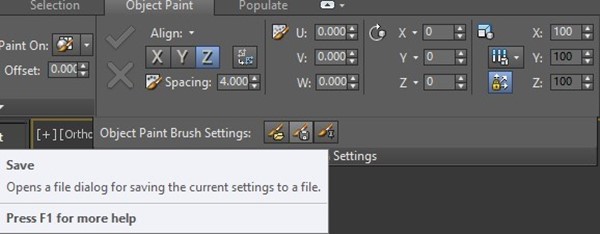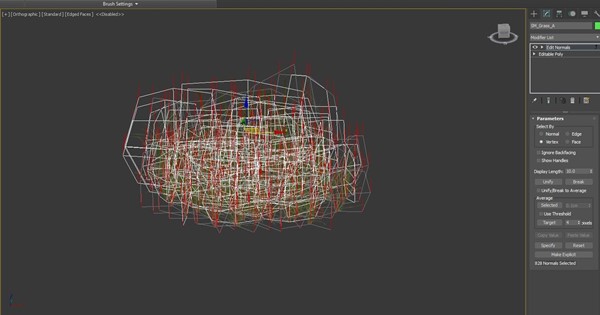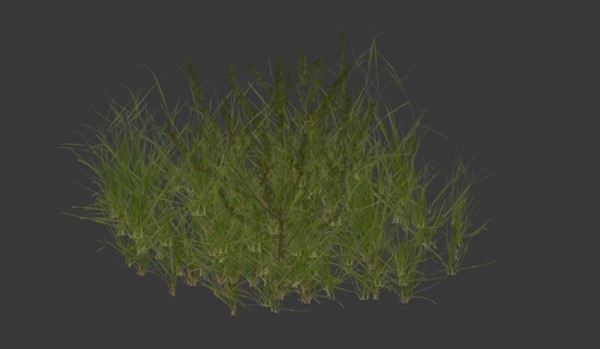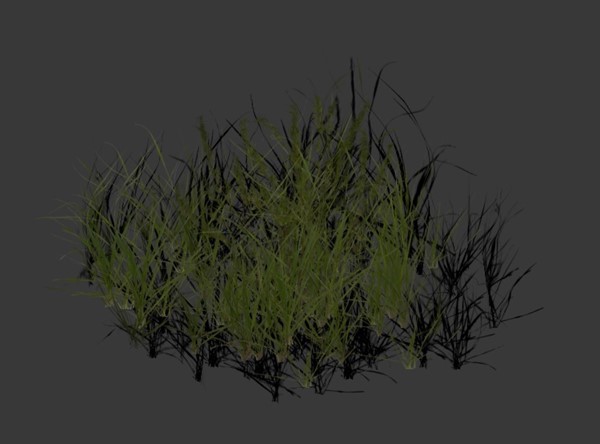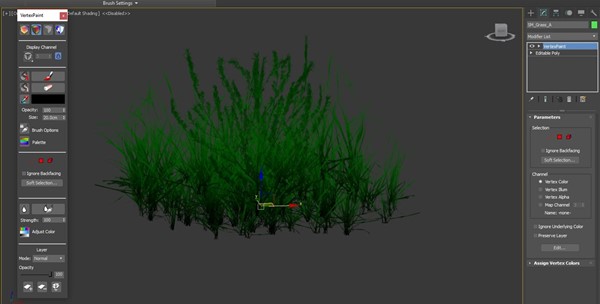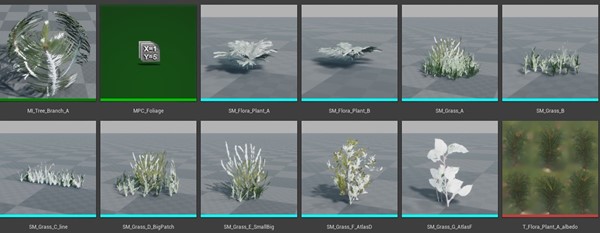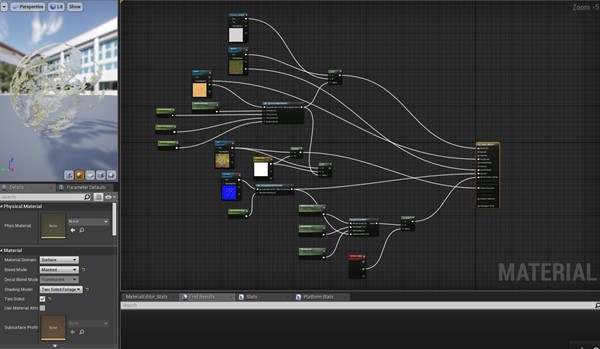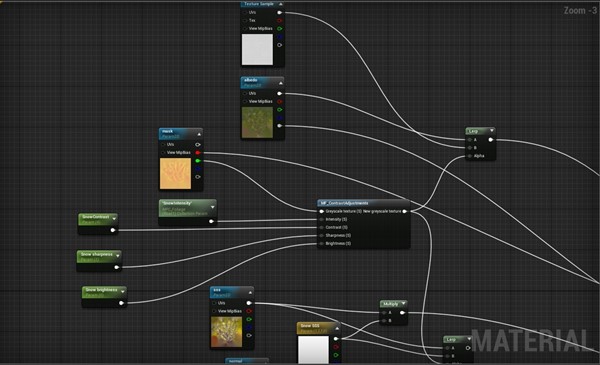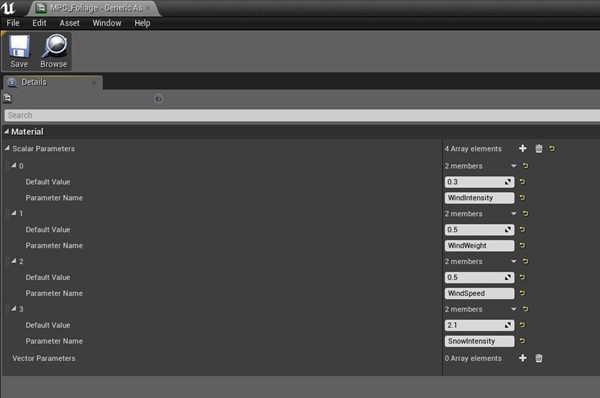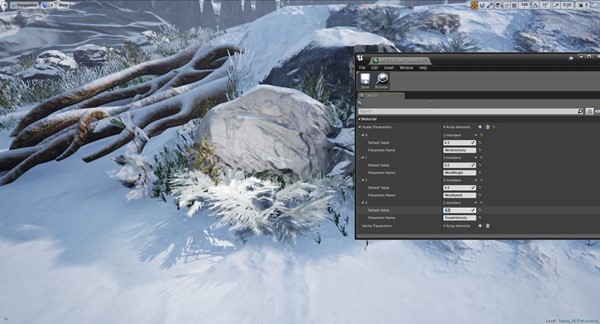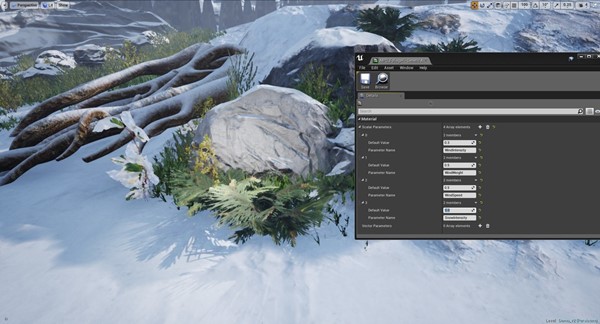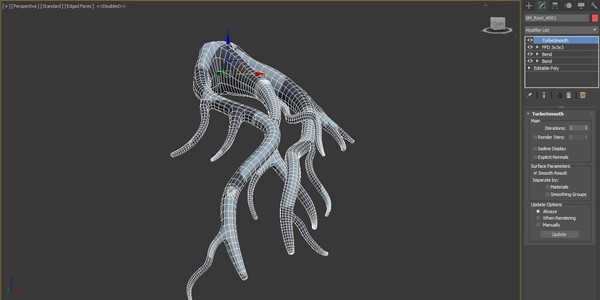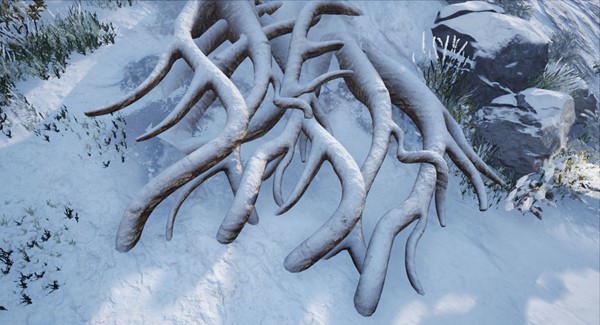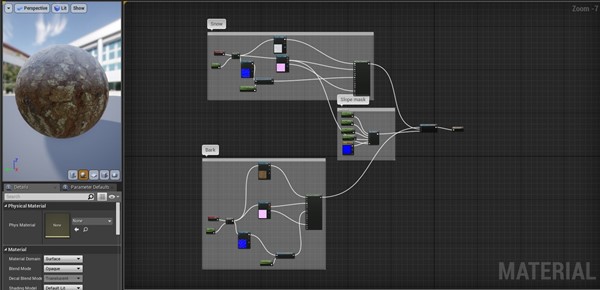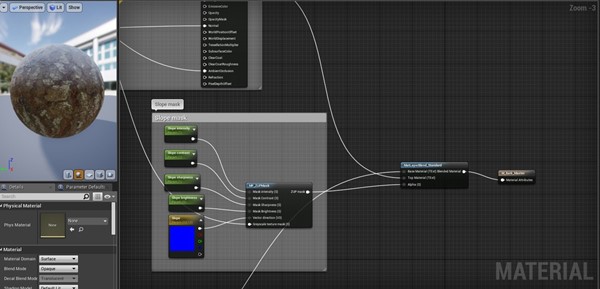(转)CGMA - Organic World Building in UE4: week 6
原文:丢失,这篇是艺术家博客上发现的,小道整理笔记中,临时放于效果案例目录。
|
In this week we focused on creating the grass and flora to decorate your map. I used a bunch of Megascan assets I got from some time ago that I thought they worked well for the scene. We also created some roots we can use in our environment. I wanted to share with you some tips and advice I got during this week on creating foliage. This is how the scene looks with some foliage on:
Foliage I brake down the assets so that they can be used in different situations and can blend with the environment different. These are some of the foliage I created for this scene:
As you can see, I have some big patches and some small patches. Also, different kinds of grass i grabbed from my references and some flowers I could use to break up the repetition when painting foliage. It's important to arrange the grass planes so that they go around a circle instead of a box. To speed up the workflow I used the Object Paint mode inside 3ds Max to paint different grass planes with different variations. I can then adjust them manually if I don't like the result but I found this was a good way to start creating the assets.
I would just play with the settings and find something I like that works for what I'm looking for. After that, I can save the preset and use it in the rest of the assets I want to create.
After that's done, I would adjust the vertex normals so they can blend nicely with the ground. I do that by using the Edit Normals tool and move them so that they can point upwards.
This is how the asset looks with the vertex normals changed:
This is how the asset looks without the vertex normals changed:
As you can see, the asset can blend nicely with the light when you change the normals. You can also transfer the vertex normals of a sphere and make it look nicer, which is something I may do to tweak the scene later on. Finally, you want to add some vertex colors to mask the vertices you don't want to move when applying a vertex offset to simulate wind in the environment.
In this case, I painted green on the vertices I wanted to be affected by the wind and black for the vertices I wanted to stay still. You want to have enough variations to have big, medium and small shapes. That way you can have really cool transitions in your environments and apply the same principle of Primary, Secondary and Tertiary shapes with all the assets you create.
For the Material, I'm using 4 textures: Albedo with opacity, SSS color, normals and a mask texture with roughness, height and spec map.
As you can see I'm using a Material parameter collection to change the values instead of using a common Parameter. The reason is that I want to iterate on all the assets at once to have an overall look of the scene. I can later change each material instance indivitualy but this is a good way to add global parameters to your scene. It can be used to change the roughness of all your assets in a rainy day or add a snow parameter on top. Really powerful stuff. This is how my Material Parameter Collection looks like:
That way I can change global parameters in the scene like the snow: Snow intensity at 2.1:
Snow intensity at 0:
I still need to change the textures so it can look nicer with the snow but it is a good start. Roots A great thing about the course is that Anthony teaches us how to create roots for your scene. They can make it look really believable and add an extra layer of complexity to the scene.
The way you create the roots is by using splines and then add some geometry and connect the vertices. You don't necessarily need to make a high poly model since the textures can do the work and also you can also smooth the mesh and add extra little details like bumps in the geometry to help sell the asset. Here is a video when I show the process since it can be easier be explained there than a text: After that is done, it is just a matter of UV the mesh so you can then apply some tiling materials on it and use an FFD modifier to rotate the mesh and create different variations. You can also use bones and skin the mesh to manipulate the roots individually. This is how the mesh looks with the materials applied:
Here is how the material graph looks, it is simply blending 2 different materials using the slope shader:
Biggest takeaways:
|
(转)CGMA - Organic World Building in UE4: week 6的更多相关文章
- UDKtoUE4Tool-UDKUE3资源移植UE4工具
UDKtoUE4Tool UDKtoUE4Tool 是一个把UE3/UDK资源包(T3D格式)转换成UE4(T3D格式)的工具.作者Matt3D使用C#实现,未来考虑发布到Unreal Marketp ...
- [UE4]The global shader cache file missing 运行错误解决办法
UE4项目在VS中对项目代码编译时报如错,找了好久在UE4论坛上查到了别人的解决方案,贴出来仅供大家参考. 看到一位开发者解释出错的原因如下: There are a number of build ...
- Ubuntu 15.04 编译UE4 for Linux版
源 起 Unreal Engine 4 是全球最先进的Realtime Illumination & Physical 引擎: 长期以来,UE4都只有Windows版和Mac版,今年终于向Li ...
- Aery的UE4 C++游戏开发之旅(4)加载资源&创建对象
目录 资源的硬引用 硬指针 FObjectFinder<T> / FClassFinder<T> 资源的软引用 FSoftObjectPaths.FStringAssetRef ...
- 【UE4】虚幻引擎技术直播汇总(含中英文直播)
B站虚幻引擎官方账号 中文直播 [中文直播]第35期 | 使用GIS在UE中创造真实地球风貌 | Epic 周澄清 [中文直播]第34期 | 包教包会的Epic MegaGrants申请之道 | Ep ...
- UE4新手引导之下载和安装虚幻4游戏引擎
1) 进入虚幻4的官方主页(https://www.unrealengine.com/) 这里你可以获得关于虚幻4的最新资讯,包括版本更新.博客更新.新闻和商城等.自2015年起,该引擎已经提供免费下 ...
- UE4新手引导入门教程
请大家去这个地址下载:file:///D:/UE4%20Doc/虚幻4新手引导入门教程.pdf
- Building the Testing Pipeline
This essay is a part of my knowledge sharing session slides which are shared for development and qua ...
- BZOJ 4742: [Usaco2016 Dec]Team Building
4742: [Usaco2016 Dec]Team Building Time Limit: 10 Sec Memory Limit: 128 MBSubmit: 21 Solved: 16[Su ...
随机推荐
- golang刷Leetcode系列 --- 实现strStr()
实现 strStr() 函数. 给定一个 haystack 字符串和一个 needle 字符串,在 haystack 字符串中找出 needle 字符串出现的第一个位置 (从0开始).如果不存在,则返 ...
- Linux 学习第五天
一.重定向.管道符.通配符 1.重定向.管道符使用 重定向: 命令文件 管道符: 命令A:命令B (管道符 | 别称 “任意门”) 二.常用命令 1.ls /etc | wc -l (查看目录 ...
- [异常笔记]启动DFS报错:Cannot find configuration directory: /etc/hadoop
[hadoop@master ~]$ start-dfs.sh Incorrect configuration: namenode address dfs.namenode.servicerpc-ad ...
- 一道关于js正则表达式的面试题
这道面试题明显是要用到正则表达式来解决的,由于太久没有写正则表达式了,一时之间竟然写不出来,所以记录一下笔记,下面直接上代码: function parseUrl(str) { // 判断是否传入参数 ...
- Win7配置express4环境
本机环境: $ node -v v10.14.1 $ npm -v 6.4.1 配置node环境变量: #配置全局安装目录 npm config set prefix "G:\WEB\nod ...
- hadoop生态搭建(3节点)-13.mongodb配置
# 13.mongodb配置_副本集_认证授权# ==================================================================安装 mongod ...
- 嵌入式LInux之C语言提升篇---Skr Skr Up Up
嵌入式C语言提升 致敬:每一个奋斗的人! Up Up UpC语言常见编译错误1.预处理错误 -E 1-1 找不到源文件错误 自己定义头文件 使用 “xxx.h” 搜索的目录 ./ ...
- Django时间时区问题
在django1.4以后,存在两个概念 naive time 与 active time. 简单点讲,naive time就是不带时区的时间,Active time就是带时区的时间. 举例来说,使用d ...
- Python学习笔记六:集合
集合 Set,去重,关系测试:交.并.差等:无序 list_1=set(list_1), type(list_1) list_2=set([xxxxx]) 交集:list_1.intersectin( ...
- 通过burpsuite替换cookie登录后台
通过burpsuite可以比较方便的替换http头部的cookie.useragent等字段,在获取到用户的cookie后实现登录.具体使用方法如下: 如替换cookie,可以写正则表达式^Cooki ...

